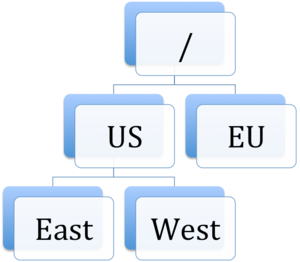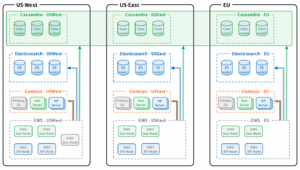(→Topology) |
(→Topology) |
||
| Line 6: | Line 6: | ||
A multiple datacenter deployment implies a logical partitioning of all GWS nodes into segregated groups that are using dedicated service resources, such as T-Server, StatServers, and so on. | A multiple datacenter deployment implies a logical partitioning of all GWS nodes into segregated groups that are using dedicated service resources, such as T-Server, StatServers, and so on. | ||
| − | |||
The topology of a GWS Cluster can be considered as a standard directory tree where a leaf node is a GWS data center. The following diagram shows a GWS Cluster with 2 geographical regions (US and EU), and 3 GWS datacenters (East and West in the US region, and EU as its own datacenter). | The topology of a GWS Cluster can be considered as a standard directory tree where a leaf node is a GWS data center. The following diagram shows a GWS Cluster with 2 geographical regions (US and EU), and 3 GWS datacenters (East and West in the US region, and EU as its own datacenter). | ||
[[File:gws_multidatacenters-topo_851.png|thumb|left]] | [[File:gws_multidatacenters-topo_851.png|thumb|left]] | ||
| + | |||
| + | For data handling and distribution between GWS datacenters, the following third-party applications are used: | ||
| + | * Cassandra—A NOSQL database cluster with multiple datacenters with data replication between each other. | ||
| + | * Elasticsearch—A search engine which provides fast and efficient solution for pattern searching across Cassandra data. Genesys recommends that each GWS datacenter have an independent, standalone Elasticsearch cluster. | ||
| + | |||
| + | ==Architecture== | ||
| + | A typical GWS datacenter in a multiple datacenter deployment consists of the following components: | ||
| + | * 2 APINodes | ||
| + | * 2 StatNodes | ||
| + | * 3 Cassandra nodes | ||
| + | * 3 ElasticSearc nodes | ||
| + | * 1 SyncNode (only for Primary region) | ||
| + | |||
| + | The following disgram illustrates the architecture of this sample multiple datacenter deployment. | ||
| + | |||
| + | [[File:gws_multidc-arch_852.png|thumb|left]] | ||
| + | |||
| + | |||
| + | |||
| + | |||
{{Chgbar_close}} | {{Chgbar_close}} | ||
Revision as of 14:38, July 6, 2017
Multiple Datacenter Deployment
Starting in release 8.5.1, GWS supports a deployment with multiple (two or more) datacenters. This section describes a this type of deployment.
Overview
A multiple datacenter deployment implies a logical partitioning of all GWS nodes into segregated groups that are using dedicated service resources, such as T-Server, StatServers, and so on.
The topology of a GWS Cluster can be considered as a standard directory tree where a leaf node is a GWS data center. The following diagram shows a GWS Cluster with 2 geographical regions (US and EU), and 3 GWS datacenters (East and West in the US region, and EU as its own datacenter).
For data handling and distribution between GWS datacenters, the following third-party applications are used:
- Cassandra—A NOSQL database cluster with multiple datacenters with data replication between each other.
- Elasticsearch—A search engine which provides fast and efficient solution for pattern searching across Cassandra data. Genesys recommends that each GWS datacenter have an independent, standalone Elasticsearch cluster.
Architecture
A typical GWS datacenter in a multiple datacenter deployment consists of the following components:
- 2 APINodes
- 2 StatNodes
- 3 Cassandra nodes
- 3 ElasticSearc nodes
- 1 SyncNode (only for Primary region)
The following disgram illustrates the architecture of this sample multiple datacenter deployment.


